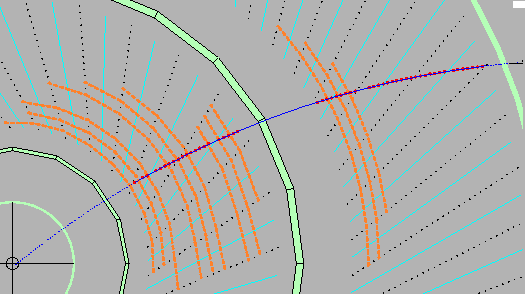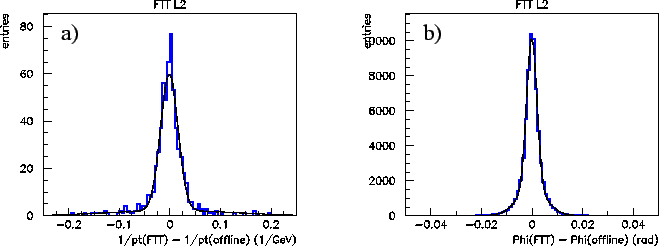The H1 Collaboration has upgraded the trigger electronics (described in section 5.7) in order to be able to improve the signal to background ratio and to collect useful physics events while suppressing the triggering of events that are not of interest or are beam-related background.
The H1 Fast Track Trigger (FTT) [237]
implements charged track finder and mass
reconstruction algorithms in the first three levels of the H1
trigger scheme.
For the charged particle track reconstruction at the first trigger
level 1 (2.3 ![]() s) and level 2 (23
s) and level 2 (23 ![]() s), the FTT makes
use of Field Programmable Gate Arrays (FPGA)
and their embedded Content Addressable Memories (CAM).
The track parameters are determined by comparing hit-patterns with
predefined masks
implemented in digital signal processors (DSP).
The FTT can reconstruct up to 48 tracks which is sufficient
for about 98% of the events of interest.
s), the FTT makes
use of Field Programmable Gate Arrays (FPGA)
and their embedded Content Addressable Memories (CAM).
The track parameters are determined by comparing hit-patterns with
predefined masks
implemented in digital signal processors (DSP).
The FTT can reconstruct up to 48 tracks which is sufficient
for about 98% of the events of interest.
The FTT functionality is based on hit information in the central
jet chambers CJC. In fig.56,
the geometrical cell structure of both chambers is sketched.
In the first step track segments are formed separately
in four groups of three layers of wires each.
A fast track segment linking, based on matches of track segments in
![]() and
and ![]() is
completed within 2
is
completed within 2 ![]() s to provide level 1 trigger decisions
based on charged track multiplicities and charged particle
topologies for coarse
s to provide level 1 trigger decisions
based on charged track multiplicities and charged particle
topologies for coarse ![]() cuts.
The result is used by the second level FTT where the track segments
are linked and re-fitted to better precision
within 20
cuts.
The result is used by the second level FTT where the track segments
are linked and re-fitted to better precision
within 20 ![]() s including the determination
of event quantities like a refined track multiplicity, momentum
sums and invariant masses for low multiplicity events.
Figure 57
shows the measured precision for FTT tracks at level 2.
The resolutions are given here with respect to the full
off-line reconstruction. The resolution in
s including the determination
of event quantities like a refined track multiplicity, momentum
sums and invariant masses for low multiplicity events.
Figure 57
shows the measured precision for FTT tracks at level 2.
The resolutions are given here with respect to the full
off-line reconstruction. The resolution in ![]() is approximately
is approximately
![]() , approximately 2 mrad in
, approximately 2 mrad in ![]() and 75 mrad in
and 75 mrad in ![]() .
.
The track parameters of the fitted tracks are sent to FTT L3 where
a farm of commercial processor boards is used to perform
a full search for particle resonances within 100 ![]() s.
The L3 track information is either used directly or in
combination with information from other trigger subsystems to
generate a final L3 decision.
s.
The L3 track information is either used directly or in
combination with information from other trigger subsystems to
generate a final L3 decision.
 |
 |
In addition to upgrading the drift chamber trigger,
the H1 experiment has improved the robustness against severe background
conditions by replacing its double layer central inner multi-wire
proportional chamber by a chamber with five layers of pads
with geometry projective to the ![]() -position of the
-position of the ![]() interactions.
The new detector has ten times more channels and, like the old
proportional chamber, provides trigger decisions,
based on a
interactions.
The new detector has ten times more channels and, like the old
proportional chamber, provides trigger decisions,
based on a ![]() -vertex histogramming technique,
at level 1, within a latency of 2.3
-vertex histogramming technique,
at level 1, within a latency of 2.3 ![]() s.
s.